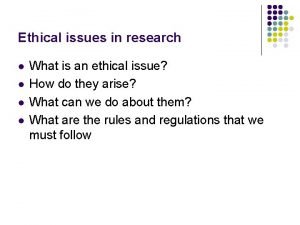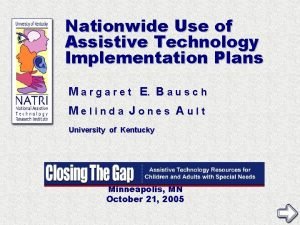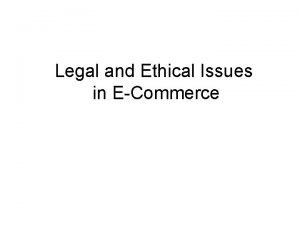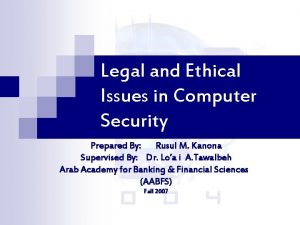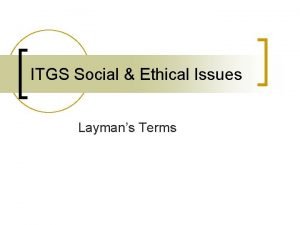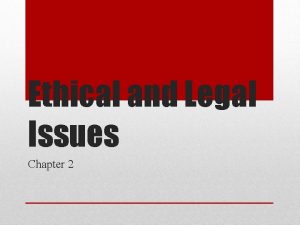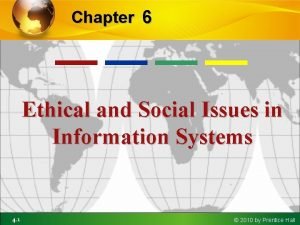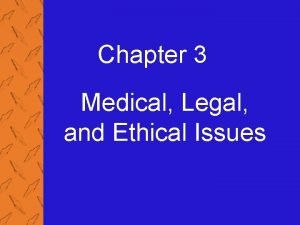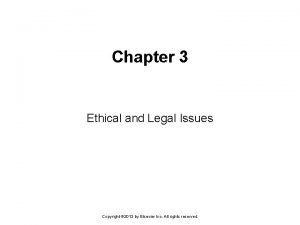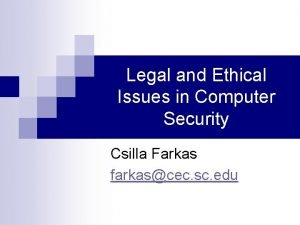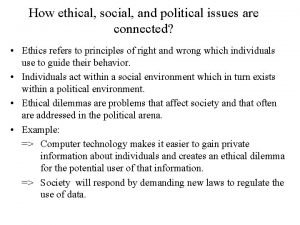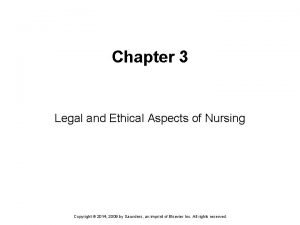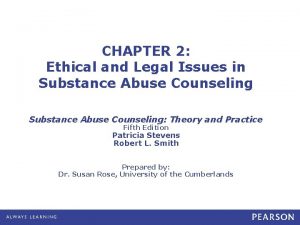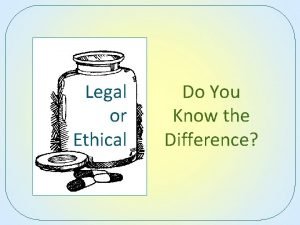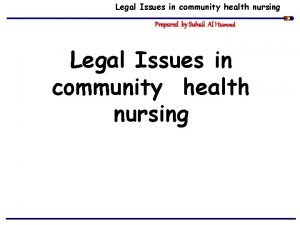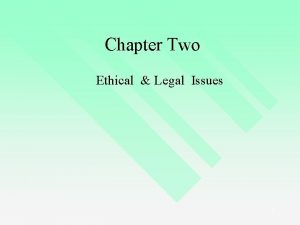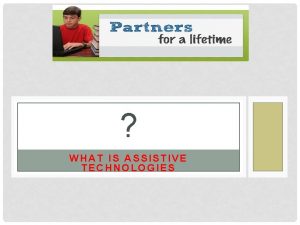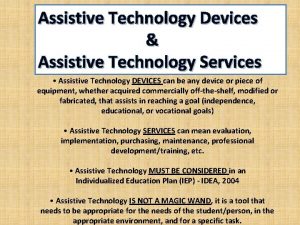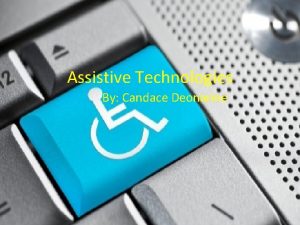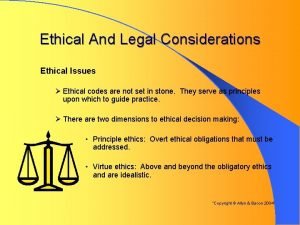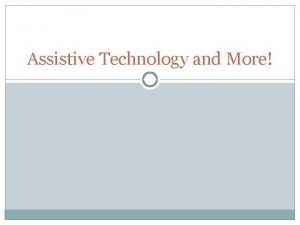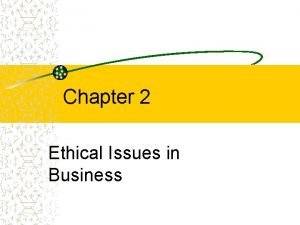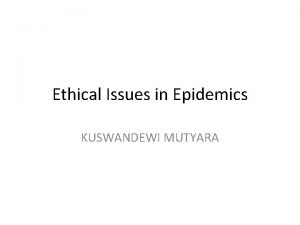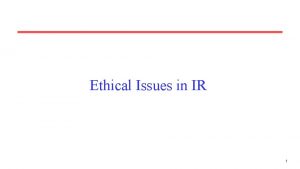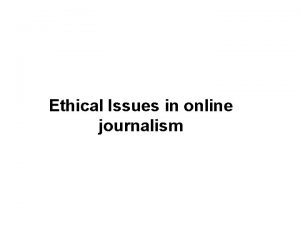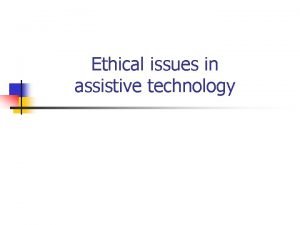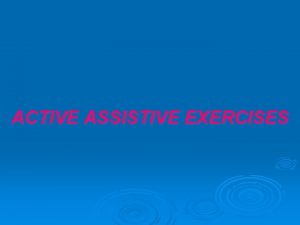Assistive technologies ethical issues and ethical research Andrew


![Ethical interpretation Sommerville (2003: 283) ‘interpretation of the terms [for example, harm and benefit], Ethical interpretation Sommerville (2003: 283) ‘interpretation of the terms [for example, harm and benefit],](https://slidetodoc.com/presentation_image_h2/8257657a61ab4d08fb5d731f964551f4/image-3.jpg)






























- Slides: 33

Assistive technologies: ethical issues and ethical research Andrew Eccles University of Strathclyde

Ethical framework(s) in common telecare use Care Services Improvement Partnership Social Care Institute for Excellence Scottish Government Based on four principles (Beauchamp and Childress, 2001) Beneficence, Non-maleficence, Autonomy, Justice This is a limited (essentially biomedical) framework yet pervasive in its use across discussion around Telecare
![Ethical interpretation Sommerville 2003 283 interpretation of the terms for example harm and benefit Ethical interpretation Sommerville (2003: 283) ‘interpretation of the terms [for example, harm and benefit],](https://slidetodoc.com/presentation_image_h2/8257657a61ab4d08fb5d731f964551f4/image-3.jpg)
Ethical interpretation Sommerville (2003: 283) ‘interpretation of the terms [for example, harm and benefit], depends in different contexts on a number of variables, including individuals’ perceptions as well as legal and professional benchmarks’ Limits to how much a framework can embrace if used in assessing

• The appropriateness of biomedical frameworks; acute dilemmas or life affirming care? • The common understanding of these frameworks across professions ‘[the need to] address an ethical and democratic deficit in this field which has arisen due to a proliferation in research and development of advanced care technologies that has not been accompanied by sufficient consideration of their social context’ (Mort M, Roberts C, Milligan C, 2009)

The ‘primacy of autonomy’ (Wilmot, 1997) How are these perceived across professions and/or different sites? Cultural sensitivity to care needs: Tao and Driver (1997) on autonomy in different contexts If we go beyond the ethical frameworks what ethical issues emerge?

Independence but isolation? Astrid (2001) framework warns of potential for isolation in the use of technology Lowe (2009) surveys literature linking isolation to depression and notes potential attendant costs for health care. Will depression be detected? If so, will it be dealt with adequately and on whose budget? Is a system (for example ‘befrienders’) being developed in tandem with Telecare at an adequate pace?

Justice as inclusion Need for telephone landline for telecare monitors to work: excludes ‘pay as you go’ service users Ideally access needed to broadband to monitor a ‘just checking’ system by family members 3 rd generation AT will rely more on mobile technology and network capability: familiarity with, and confidence to negotiate technology

• Barnes (2008) on the limitations of ethical frameworks • The merits of relational ethics • The need for contextual ethics • The need to examine intuitional ethics in the context of remote decision making

An ethic of care Ethical decisions are contextual, relational and based on reciprocity in which rule based decisions are insufficient (but nonetheless set the agenda) Barnes (2006): the way in which care workers go beyond tasks to develop relationships beyond contractual obligations: care as a moral activity (and the impact of change to circumstances of care) Care for people (for example with physical disability) as a tool through which others are able to dominate and manage lives (Barnes 2007).

Is a ‘checklist’ bio-medical ethical framework adequate for the needs of different telecare user groups and are assessors sensitive enough (for example to risk) in its interpretation? If ethics are contextual, then ought the context of older people and people with disabilities be subject to the same ethical framework? Does the framework have enough latitude for interpretation for different groups? If so, how is this being applied to assessment for Telecare technologies?

Care as a moral activity (Tronto, 1993) Attentiveness: Responsibility: Competence: Responsiveness: to recognise and be attentive to others to take responsibility for action caring work should be competently performed consider the position of the carereceiver from their perspective – it is only possible to know if caring needs have been met by focussing on the experience of receiving care

• Connectivity and access to connectivity: a social justice perspective • Care workers and a reciprocity of care • The potential for isolation and depression

• Contextual angle • An ethic of care versus an ethic of justice in telecare application • The impact of remote care delivery in decision making

LMD evaluation Hanson, Osipovic, Percival (2009, 111) evaluation of Lifestyle Monitoring Devices conclude: ‘In order to make ‘sense of sensors’ alongside the data provided by the devices, one needs rich contextual information that is normally accumulated through social interactions between caregivers and care receivers, a two-way communication process that can best be described as a ‘dialogue of care’.

Virtue ethics Recourse to the moral character of professionals in addition to value bases across professions Banks & Docherty (2009) Whose virtues? Value bases across professions? ) Who assesses?

Recourse to the moral character of professionals in addition to value bases across professions Banks & Docherty (2009) Whose virtues? Value bases across professions? Who assesses? Who gatekeeps the assessment?

Intuitionism (Driver, 2007) intuitionism as an additional dimension to ethical frameworks Does the delivery of care through remote monitoring lead to a shift in ethical appreciation of the situation?

Performance indicators Reduce the Number of Avoidable Emergency Admissions and Readmissions to Hospital bed days saved through telecare supported discharge Reduce the use of care homes Improve quality of life for users of telecare services Reduce pressure on informal carers

Performance measurement Scottish Government categories of telecare partnership performance Criteria underpinning these unclear to Telecare Project Managers Telecare packages (supplied by Scottish Government ‘partner’ company) met with concern across sites A and B

Is a ‘checklist’ bio-medical ethical framework adequate for the needs of different telecare user groups and are assessors sensitive enough (for example to risk) in its interpretation? If ethics are contextual, then ought the context of older people and people with disabilities be subject to the same ethical framework? Does the framework have enough latitude for interpretation for different groups? If so, how is this being applied to assessment for Telecare technologies?

• The performance indicator framework and ethical deliberations • The unethical attractions of meeting the performance indicators • Practical wisdom in a performance indicator world • Context and justice: should all user groups be subject to the same performance criteria?

• Research with front line staff (n= 15) assessing for telecare and telecare project managers (n=3) • Three sites, urban/rural mix, purposive sample across social work and health settings, semi- structured interviews • Policy drivers • Ethical codes (and the virtuous practitioner) • Ethical issues as part of telecare training

Different responses from front line staff from based on and the approaches of assessors to human care / telecare Depends on circumstances Technology less intrusive Human care has ‘got to be better’ Resistance to use based on employment considerations

Some issues for discussion • What ethical issues are raised when the choice is telecare or no care? • Are the ethical issues raised by this potentially being the only type of care available better accommodated by a biomedical ethical framework than an ethic of care?

What happens to fulfilling the performance indicators if technology is not employed? If human care services would be more appropriate in the place of telecare at some future point is there a contingent workforce when Telecare technology is no longer appropriate?

Banks, S. , & Gallagher, A. (2009). Ethics in professional life: Virtues for health and social care. Basingstoke: Palgrave Macmillan. Barnes, M. (2006). Caring and social justice. Basingstoke: Palgrave Mac. Millan. Beale, S. (2009). Evaluation of the Scottish government’s telecare programme. Paper presented at the Technology and Human Services Conference, University of Strathclyde, Glasgow. Beauchamp, L. , & Childress, A. F. (2001). Principles of biomedical ethics (5 th ed. ). Oxford: Oxford University Press. Blaschke, C. , Freddolino, P. , & Mullen, E. (2009). Ageing and technology: A review of the research literature. British Journal of Social Work, 39, 641– 656. Bowling, A. , & Dieppe, P. (2005). What is successful aging and who should define it? British Medical Journal, 331, 1548– 1551. Care Services Improvement Partnership. (2005). Telecare and ethics. London: Crown Copyright. Driver, J. (2007). Ethics: The fundamentals. Oxford: Blackwell. Eccles, A. (2008). Singe shared assessment: The limits to ‘‘quick fix’’ implementation. Journal of Integrated Care, 16(1), 22– 30. 550

Eccles, A. (2010). Ethical considerations around the use of Telecare technologies. Journal of Technology in Human Services, 28, 44 -59 European Union Public Health Information System. (2009). Population projections. Retrieved February 5, 2010, from http: //www. euphix. org/object_document/ o 5116 n 27112. html Freedland, J. (2009). The perfect gift? How about an end to loneliness—And not just at Christmas. Retrieved December 22, 2009, from http: //www. guardian. co. uk/ commentisfree/2009/dec/22/loneliness-at-christmas-public-services Frisby, B. (2000). ASTRID—A guide to using technology in dementia care. London: Hawker. General Register Office for Scotland. (2009). Projected population of Scotland. Retrieved February 6, 2010, from http: //www. gro-scotland. gov. uk/statistics/ publications-and-data/popproj/projected-population-of-scotland-2008 -based/ list-of-tables. html

Girling, J. (2007). Ethics and the management of health and social care. In A. Leathard & S. Mc. Laren (Eds. ), Ethics: Contemporary challenges in health and social care (pp. 157– 168). Bristol: Policy Press. Hanson, J. , Osipovic, D. , & Percival, J. (2009). Making sense of sensors. In B. Loader, M. Hardey & L. Keeble (Eds. ), Digital welfare for the third age (pp. 91– 111). London: Routledge. Held, V. (2006). The ethics of care: Personal, political, global. New York: Oxford University Press. Henwood, M. (1994). Fit for change? Snapshots of community care reforms one year on. London: Nuffield Institute Leeds=Kings Fund Centre. Irvine, R. , Kerridge, I. , Mc. Phee, J. , & Freeman, S. (2002). Interprofessionalism and ethics: Consensus or clash of cultures? Journal of Interprofessional Care, 16(3), 199– 210. Johnstone, J. (2007). Technology as empowerment: A capability approach to computer ethics. Ethics and Information Technology, 9, 73– 87.

Leathard, A. , & Mc. Laren, S. (Eds. ) (2007). Ethics: Contemporary challenges in health and social care. Bristol: Policy Press. Loader, B. , Hardey, M. , & Keeble, L. (Eds. ) (2009). Digital welfare for the third age. London: Routledge. Loughlin, M. (2002). Ethics, management and mythology. Abingdon: Radcliffe Medical Press. Lowe, C. (2009). Beyond telecare: The future of independent living. Journal of Assistive Technologies, 3(1), 21– 23. Lymbery, M. (2005). Social work with older people. London: Sage. Mc. Creadie, C. , & Tinker, A. (2005). The acceptability of assistive technology to older people. Ageing and Society, 25, 91– 110. Meagher, G. , & Parton, N. (2004). Modernising social work and the ethics of care. Social Work and Society, 2(1), 10– 27.

Means, R. , Richards, S. , & Smith, R. (2008). Community care (4 th ed). Basingstoke: Palgrave. Morbey, H. , Smith, R. , & Means, R. (2002). From community care to market care: The development of welfare serves for older people. Oxford: Polity. Mort, M. , Roberts, C. , & Milligan, C. (2009). Ageing, technology and the home: A critical project. European Journal of Disability Research, 3, 85– 89. Noddings, N. (1984). Caring: A feminine approach to ethics and moral education. Berkeley: University of California Press. Page, R. (2007). Revisiting the welfare state. Buckingham: Open University Press. Phillips, J. (2007). Care. Oxford: Polity. Pols, J. , & Moser, I. (2009). Cold technologies versus warm care? On affective and social relations with and through care technologies. European Journal of Disability Research, 3, 159– 178.

Powell, M. , & Dowling, B. (2006). New labour’s partnerships: Comparing conceptual Q 4 models with existing forms. Social Policy and Society, 5(2), 305– 314. Ratto, M. (2007). Ethics of seamless infrastructures: Resources and future directions. International Review of Information Ethics, 8, 21– 27. Reynolds, C. , & Pickard, R. (2005). Evaluation of affective computing systems from a dimensional metaethical position. Proceedings of the 1 st Augmented Cognition Conference, in conjunction with the 11 th International Conference on Human– Computer Interaction. Retrieved February 2, 2010, from http: //citeseerx. ist. psu. edu/viewdoc/download? doi=10. 1. 1. 68. 733&rep=rep 1&type=pdf Scottish Government. (2008 a). Seizing the opportunity: Telecare strategy 2008– 10. Edinburgh: Crown Copyright. Scottish Government. (2008 b). Telecare in Scotland: Benchmarking the present, embracing the future. Edinburgh: Crown Copyright. Scottish Government. (2009). Evaluation of the Telecare Development Programme: Final report. Edinburgh: Crown Copyright.

Sommerville, J. (2003). Juggling law, ethics and intuition: Practical answers to awkward questions. Journal of Medical Ethics, 29, 281– 286. Steyaert, J. , & Gould, N. (2009). Social work and the changing face of the digital divide. British Journal of Social Work, 39(4), 740– 753. Ethics of Telecare Technologies 15 Tao, J. , & Drover, G. (1997). Chinese and Western notions of need. Critical Social Policy, 17, 5– 25. Taylor, J. R. , Groleau, C. , Heaton, L. , & Van Every, E. (2000). The computerization of work: A communication perspective. Thousand Oaks, CA: Sage. Tinker, A. (1997). Older people in modern society. London: Longman. Townsend, P. (2006). Policies for the aged in the 21 st century: More ‘‘structured dependency’’ or the realisation of human rights? Ageing and Society, 26(2), 161– 179.

Tronto, J. (1993). Moral boundaries: A political argument for an ethic of care. London: Routeledge. Tunstall. (2009). Support for carers: Solutions for independent living. Retrieved February 2, 2010, from http: //www. tunstall. co. uk/assets/literature/Carers% 20 guide. pdf Wilmot, S. (1997). The ethics of community care. London: Cassell.
 Ethical consideration in experimental research sample
Ethical consideration in experimental research sample Ethical issues in qualitative research chapter 4
Ethical issues in qualitative research chapter 4 What is ethnography
What is ethnography Ethical issues in research
Ethical issues in research National assistive technology research institute
National assistive technology research institute Legal and ethical issues in media
Legal and ethical issues in media Law and ethics in information security
Law and ethics in information security Legal and ethical issues in use of ict
Legal and ethical issues in use of ict What is ethical issues in e commerce
What is ethical issues in e commerce Legal and ethical issues in computer security
Legal and ethical issues in computer security Professional and ethical issues during internship
Professional and ethical issues during internship Social and ethical issues itgs
Social and ethical issues itgs Ethical issues in accounting and finance
Ethical issues in accounting and finance Professional issues in information system
Professional issues in information system Ethical and legal issues chapter 2
Ethical and legal issues chapter 2 Ethical and social issues in information systems doc
Ethical and social issues in information systems doc Chapter 3 medical legal and ethical issues
Chapter 3 medical legal and ethical issues Chapter 3 ethical and legal issues
Chapter 3 ethical and legal issues Ethical issues in computer security
Ethical issues in computer security How ethical social and political issues are connected
How ethical social and political issues are connected Legal and ethical issues chapter 5
Legal and ethical issues chapter 5 Emt chapter 3 medical legal and ethical issues
Emt chapter 3 medical legal and ethical issues Chapter 6 legal and ethical issues
Chapter 6 legal and ethical issues Chapter 5 legal and ethical responsibilities
Chapter 5 legal and ethical responsibilities Chapter 4 ethical issues
Chapter 4 ethical issues Legal and ethical aspects of nursing chapter 3
Legal and ethical aspects of nursing chapter 3 Ethical and legal issues chapter 2
Ethical and legal issues chapter 2 Chapter 2 ethical and legal issues
Chapter 2 ethical and legal issues Chapter 5 legal and ethical responsibilities
Chapter 5 legal and ethical responsibilities Ethical and legal issues affecting the nursing assistant
Ethical and legal issues affecting the nursing assistant What is the difference between ethical and legal issues
What is the difference between ethical and legal issues Legal aspects of community health
Legal aspects of community health Legal and ethical issues chapter 5
Legal and ethical issues chapter 5 Chapter 2 ethical and legal issues
Chapter 2 ethical and legal issues



